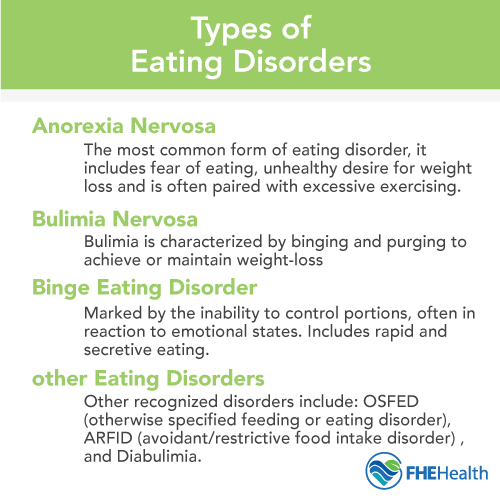The smart Trick of Eating Disorder Recovery That Nobody is Discussing
Table of ContentsEating Disorder Recovery Things To Know Before You Get ThisWhat Does Eating Disorder Recovery Do?Facts About Eating Disorder Recovery RevealedNot known Details About Eating Disorder Recovery 6 Simple Techniques For Eating Disorder Recovery

ARFID is typically considered an extreme kind of picky eating. Some youngsters are particular eaters and can be identified with ARFID because they do not take in adequate calories to develop and also expand. Adults can be identified with ARFID also, as well as along with not creating literally, they may have trouble with maintaining standard physical features.
Rumination condition is an eating condition that entails consistently spewing food. When regurgitated, the food might be re-chewed, re-swallowed or spit out. Someone with rumination disorder doesn't show up to do this purposefully. An individual with rumination problem is also unlikely to show up distressed, upset or disgusted by their constant regurgitation.
Eating Disorder Recovery Fundamentals Explained
People who are diagnosed with rumination eating disorder are frequently educated to replace the regurgitation with deep breathing strategies. Orthorexia is a fairly new term that has not yet been widely accepted. Orthorexia nervosa is not yet an acknowledged eating disorder medical diagnosis. This does not indicate that orthorexia is not dangerous.
Orthorexia is defined as a fixation with eating healthy and balanced food and also avoiding harmful food. A person with orthorexia is most likely to experience some disabilities in their life due to their fixation with healthy consuming.
Like orthorexia, diabulimia is not yet a formally recognized eating problem. Understanding exactly what diabulimia is can help recognize individuals that are having a hard time with this problem and may likewise be at risk of creating various other consuming problems.
What Does Eating Disorder Recovery Do?
, was previously recognized as Consuming Disorder Not Or Else Specified (EDNOS). An OSFED eating condition may not satisfy the analysis requirements for other eating problems yet is nevertheless major and also possibly lethal.
A person with an OSFED is just as most likely to have major medical consequences as individuals that completely fit an eating disorder diagnosis. A person that has an OSFED may be equally as most likely to pass away as a result of disordered eating as any person else with an eating condition. Eating conditions might be created by co-occurring mental health and wellness conditions as well as can cause physical problems that can be deadly.
Acknowledging the very early indication of eating problems can make a significant difference in the lasting health and wellness results created by the condition. Indications and also signs of eating disorders can be usually split into two sub-categories: behavior (as well as emotional) indications as well as physical indications. Common emotional as well as continue reading this behavioral indicators of an eating problem might not always be quickly identifiable.
8 Easy Facts About Eating Disorder Recovery Described

In scenarios where typical behavior and also psychological signs are unable to be observed, a clinical specialist may acknowledge an eating disorder solely based upon physical indications (eating disorder recovery). Some usual physical symptoms of an eating disorder include: Obvious fluctuations in weight (both gains and losses)Tummy pains, Irregular bowel movements, Heartburn, Menstruation irregularities, including loss of durations or missed out on periods, Problem concentrating or enduring attention, Dizziness or fainting, especially after standing, Resting problems, Cuts as well as calluses on fingers, Dental troubles like enamel erosion, dental caries as well as tooth sensitivity, Dry skin, hair and nails Like other psychological wellness conditions, eating problems are brought on by a combination of environmental, hereditary and social variables.
A dysfunctional hormone action to tension might suggest a susceptibility to creating an eating problem. Social scenarios connected with sporting activities, modeling or other professions concentrating on body image as well as weight control might influence the development of consuming problems.
Indicators on Eating Disorder Recovery You Need To Know
Indication differ from one person to another, yet some variables are most likely to affect an individual's threat of establishing an eating condition (eating disorder recovery). Some biological risk factors that apply to people with anorexia nervosa, bulimia nervosa or binge eating click for info disorder include: Having a relative with an eating problem, Having a household member with one more psychological health disorder Perfectionism, Body picture frustration, Background of an stress and anxiety disorderRigid reasoning Weight preconception, History of diet programs, Being teased or bullied, Limited social networks, Background of injury Similar to various other mental health disorders, consuming conditions and addictions frequently co-occur.
Furthermore, up to 35 percent of individuals with substance usage disorders likewise had an eating condition.